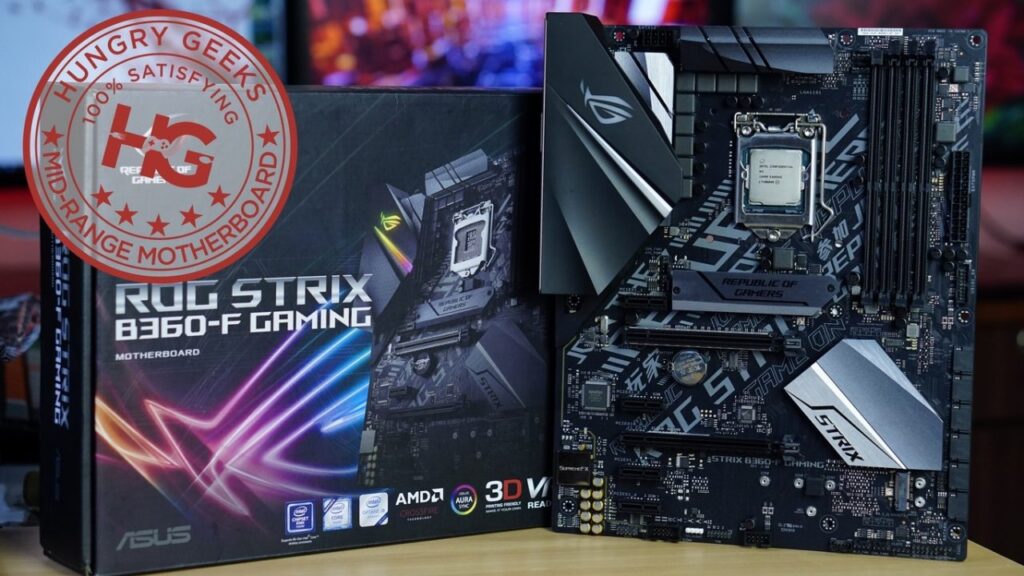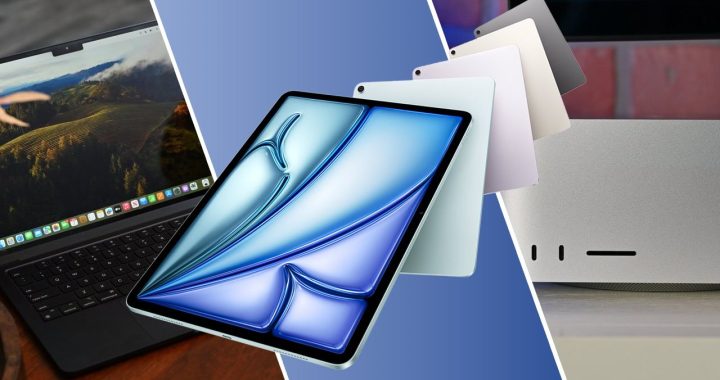ASUS ROG Strix B360-F review: ROG goes mainstream

ASUS has announced a slew of H370, B360, and H310 series motherboards to make purchasing Intel’s Coffee Lake processors a bit more bearable for the wallet. Today, we’ll be taking a look at one of ASUS ROG’s offering in the B360 space; the ASUS ROG Strix B360-F.
The ASUS ROG Strix B360-F aims to bring the ROG experience to a more budget-conscious market. Despite its budget nature, the ROG Strix B360-F still comes with features iconic of the ROG brand such as a pre-mounted I/O shield, RGB lighting, tons of connectivity, and a 3d-printing friendly design for personalization. Here are the full specifications of the ASUS ROG Strix B360-F straight from the brand’s product page.
ASUS ROG Strix B360-F
Before we review the ASUS ROG Strix B360-F, here’s a quick rundown of Intel’s Coffee Lake processors and the B360 chipset.
Intel Coffee Lake
Coffee Lake is Intel’s eight generation of desktop processors. The biggest change of Coffee Lake from the 7th generation Intel desktop processors, Kaby Lake, is that the tech giant has upped the core count of their mainstream offerings from a maximum of 4-core, 8-thread setup to a maximum of 6-core, 12-thread arrangement. Intel’s i3 would now have 4 cores and 4 threads, the i5 would have 6 cores and 6 threads, and the i7 now has 6 cores and 12 threads.
Despite the upped core count, Intel is still using its 14nm manufacturing process that has now been dubbed 14nm++. The name change is just cosmetic. Coffee Lake uses the same CPU and GPU architecture from Kaby Lake.
With the increased core count, Coffee Lake CPUs are now geared to take on workloads that require multiple cores such as editing, streaming, and sometimes, gaming. Intel is saying that their new i7, the 8700K, can get up to 25% more FPS and 45% better performance over the i7-7700K in “mega-tasking,” which means that you better overall performance if you’re system is doing multiple workloads such as playing and streaming at the same time.
Much like with their HEDT platform such as Skylake-X and Kaby Lake-X, the core count has decreased the base clock of the Coffee Lake processors compared to their previous generation siblings. For example, the i7-8700K now has a base clock of 3.7GHz instead of 4.2GHz of the i7-7700K. Despite its 500MHz disadvantage, the boost clock of the i7-8700K has been increased to 4.7GHz over the 4.5GHz of the i7-7700K.
Coffee Lake now officially supports DDR4-2666MHz memory as well as Thunderbolt 3. Of course, Optane Memory is also supported by Inte’s 8th generation processors. For the unfamiliar, Optane Memory acts as a cache for your hard drive or SSD to improve overall performance. Although we’ve heard from some of our sources that a full-fledged Optane SSD will be coming in the near future.
The B360 Chipset
Created for Intel’s Coffee Lake platform, B360 motherboards comes with Intel’s LGA 1151 v2 socket. Designed to be a budget-friendly option, the B360 chipset offers most the bells and whistles that consumers expect from a gaming motherboard.
Depending on the implementation, the B360 platform can deliver up to four USB 3.1 Gen2 ports, up to six USB 3.1 Gen1 ports, and 12 USB 2.0 ports. Connectivity also include six SATA III ports and up to twelve PCIe 3.0 lanes.
Despite having fewer PCIe lanes and the lack of CPU and RAM overclocking capabilities compared to the Z370 chipset, the B360 motherboards will still offer around the same performance as its higher-end brethren.
Now, let’s get on with the review.
Unboxing
As far as packaging goes, the ASUS ROG Strix B360-F doesn’t detract too much from other ROG products. Inside the box are some documentation, manual, cable stickers, a door sign, four SATA cables, M.2 screws, cables ties, and an RGB lead.
Up close with the ASUS ROG Strix B360-F
In terms of design, the motherboard is clad in the standard black coating that all ROG-themed products have. To separate itself from the pack, the ROG Strix B360-F has its name embossed on the PCB. In our opinion, the inclusion of the embossed name of ROG Strix as well as the sentence “Join the Republic” detract from the minimalist black design of the PCB. Some users, however, may like that so we won’t take any kind of points off in the styling department.
The board does support RGB lighting and users can connect an RGB lighting strip via the 12v RGB header down at the bottom of the board. If that’s not enough, the I/O cover also comes with its own RGB lighting. The ROG Strix B360-F does support ASUS Aura Sync so enthusiasts and gamers can synchronize RGB lighting across all supported products and peripherals.
Storage comes aplenty with the ASUS ROG Strix B360-F. There are six SATA ports at the bottom right-hand side of the board, which is a standard option for most ATX motherboards.
For faster storage, there are two M.2 ports on the board. The first one is located just at the bottom of the CPU socket that supports PCIe 3.0 x4 mode and comes with its own M.2 heatsink. The second M.2 socket is located just at the PCH that support PCIe 3.0 x2 and SATA mode.
Despite not being able to overclock, ASUS hasn’t skimped on the power delivery of the ROG Strix B360-F. The board employs the use of a 10+2 digital phase design to deliver power for both the CPU and the iGPU. It also comes with two gunmetal-themed heatsinks to cool down the VRMs.
As far as memory support goes, the ASUS ROG Strix B360-F has four DIMM slots at the right-hand side, which is fairly standard for an ATX motherboard. They support up to four RAM sticks for a maximum total capacity of 64GB at 2666MHz.
The motherboard has a SupremeFX S1220A for audio delivery. To ensure a cleaner sound, the sound chip is shielded from the rest of the motherboard. There are also Nichicon CAPs found on the board for a supreme listening experience.
The ASUS ROG Strix B360-F only has one PCIe 3.0 x16 slot going to the CPU for the GPU. The other x16 lane is a PCIe 3.0 slot that only runs x4 through the B360 chipset when a card is put on. For good measure, ASUS has also put four PCIe 3.0 x1 slots for other expansion cards.
The rear I/O is littered with connectivity options that will surely satisfy most gamers. The back I/O is comprised of a single PS/2 combo port, a Dual-Link DVI slot, one DisplayPort, an HDMI port, an RJ-45 Ethernet connection, a single USB 3.1 Gen2 Type-C port, two red USB 3.1 Gen2 Type-A ports, four USB 2.0 ports, an S/PDIF, and five 3.5mm audio jacks. ASUS was also courteous enough to pre-install the I/O plate to eliminate of incidents of forgetting to install them before placing the motherboard on your case.
The motherboard doesn’t come with a traditional POST LED code debugger but ASUS has installed their own Q-LED lights located at the top right-hand side of the board. If there’s a problem booting, one of the LED lights designated for the VGA, CPU, and DRAM will light up to signify that there’s a problem on that particular component. It doesn’t provide complete information compared to a traditional code debugger but it does the job nonetheless.
To expand cooling, the motherboard comes with six four pin connectors split into three pairs. The first pair is located just above the RAM slots. The second pair is located above the first PCIe 3.0 x1 slot while the last pair is positioned at the bottom of the board.
Since there are no CPU and RAM overclocking options on B360 motherboards, we won’t go too much into detail about the BIOS of the ASUS ROG Strix B360. But as far as options go, the BIOS on the motherboard is bog-standard compared to other ROG motherboards.
From BIOS, you can set different fan curves as well as set XMP profiles on the RAM you have installed. You can also change boot priorities and tweak the voltages of the components in your PC.
System and Benchmarks
Since there the B360 chipset doesn’t have any kind of CPU overclocking capabilities, CPU frequency has been left to its stock configuration. Here is the test setup we used in benchmarking the ASUS ROG Strix B360-F:
- CPU: Intel Core i5-8600K
- RAM: DDR4 2666MHz, 14-14-16-32
- GPU: NVIDIA GeForce GTX 1070 Founders Edition
- PSU: Seasonic G650 80+ Gold
- Storage: Plextor S1 256GB SATA SSD
- Cooler: Cooler Master Hyper 212X
- OS: Windows 10 Pro
- BIOS Version: 0602
The ASUS ROG Strix B360-F when paired with our Intel Core i5-8600K was able to perform just as we expected on our tests. Due to the more powerful single-core performance of the processor, the board was able to outclass most processors in our benchmarks. When it comes to multi-core processing, however, the lack of additional threads does show as the Ryzen 7 1700 takes the lead in some programs.
Conclusion
The ASUS ROG Strix B360-F, in essence, is a cut-down version of the ROG Strix Z370-F Gaming. Despite this, the ROG Strix B360-F is still able to deliver a well-rounded experience even without overclocking and less PCIe lanes to distribute.
Priced at PhP 9,630, the ASUS ROG Strix B360-F has tons of connectivity and storage options as well as support for RGB lighting. Customization has also been though out with support for 3D printing and a lot of cooling options found on the board.
If you’re not a fan overclocking and is satisfied running your CPU and RAM at stock speeds, then the ASUS ROG Strix B360-F will do a decent job running your PC and with its customization options. This is a motherboard serious in its position in the market. It’s with these reasons that we are awarding the ASUS ROG Strix B360-F with our 100% Satisfying Mid-range Motherboard award.
 Assassin’s Creed Shadows: 20 days of fresh castle game, launches March 20
Assassin’s Creed Shadows: 20 days of fresh castle game, launches March 20  Blade of Fire: hands-on review
Blade of Fire: hands-on review  Morgan Stanley slashes AAPL cost target to$ 252 on lower phone switch level concerns
Morgan Stanley slashes AAPL cost target to$ 252 on lower phone switch level concerns  How to use mechanical cleaners with Apple Home &, Siri
How to use mechanical cleaners with Apple Home &, Siri  Save up to$ 987 on every 2025 Mac, iPad at Apple resellers
Save up to$ 987 on every 2025 Mac, iPad at Apple resellers  UK says Apple hampers browser development, but animals out of imposing rules
UK says Apple hampers browser development, but animals out of imposing rules